Japan
Wood Products Prices
Dollar Exchange Rates of 10th
March 2017
Japan Yen 114.75
Reports From Japan
Economy performed well in 2016 but
uncertainty
looms
Increased business investment in the final quarter of 2016
lifted economic growth higher than initially reported.
Third quarter growth came in at annualised 1.2% however;
the revised figure is still below forecast prepared in mid-
2016 which anticipated growth at 1.6%.
The lackluster growth underlines the challenges facing the
Japanese government which, along with the Bank of
Japan, have been struggling to reverse the years of
economic stagnation. Japan's economy grew for four
consecutive quarters in 2016 but the latest survey of
businesses shows deep concerns about prospects in the
medium term due to rising uncertainty at which way the
global economy will move.
See:
http://www.esri.cao.go.jp/en/sna/sokuhou/sokuhou_top.html
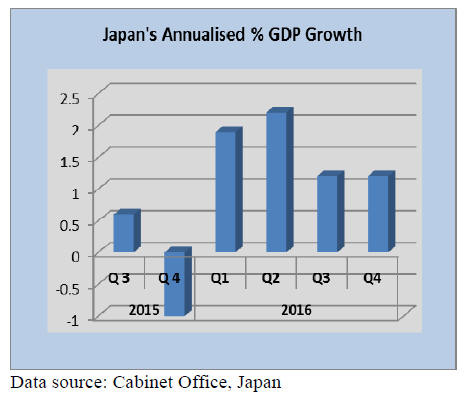
Consumer Confidence falls unexpectedly
Consumer confidence fell in February where analysts had
expected a slight improvement given the positive signs in
the index in December 2016 and again in January this
year. The consumer sentiment index dropped to 43.1 in
February from January's 40-month high.
Among the individual components assessed the overall
livelihood index fell in February as did the indices for both
income growth and willingness to buy durable goods.
The most positive result of the February survey was that
those surveyed saw improvement in employment
prospects. In January the composite employment PMI
recorded the largest advance as the workforce expanded
led by expansion in manufacturing.

Interest rate rise drives yen lower
In early March there was an unexpected weakening of the
US dollar against the yen as currency traders factored in
the likihood of a rise in US interest rates. For the month to
15 March the yen weakened slightly against the US dollar
once again pushing up the cost of imports.
The prospects are for further yen weakness as signals from
the US Federal Reserve are still pointing to a steady
increase in interest rates following the 0.25% increase just
announced.
With inflation at around 2.7% and low unemployment
pressure on prices in the US have started to rise.
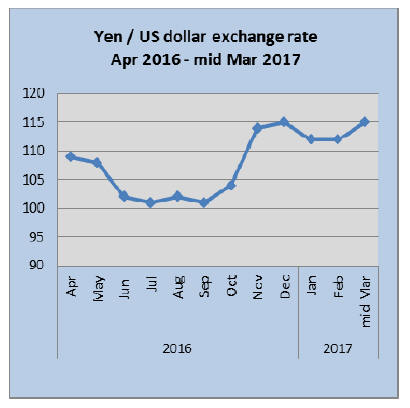
Japan remembers - a moment of silence at 2.46pm
Thousands of people in areas most affected by the massive
11 March 2011 earthquake and tsunami were still living as
evacuees in temporary makeshift homes as the country fell
into a moment of silence at 14.46 11 March 2017 marking
the 6th anniversary of the disaster.
The number of those living in makeshift homes after the
nuclear disaster had fallen by around 70% at the beginning
of this year but that still leaves over 100,000 mainly
elderly people, unable to get on with their lives.
Due to delays in the building safe permanent housing and
due to high radiation levels near the nuclear facility many
people will have to remain in temporary homes.

Import round up
Doors
Year on year Japan’s January 2017 imports of wooden
doors (HS 441820) were down 25% compared to January
2016 and from a month earlier they were down around
9%. Since September last year there has been a steady
decline in imports into Japan of wooden doors.
The top suppliers in January in order of rank were China,
Indonesia and Malaysia which together accounted for over
90% of Japan’s wooden door imports for the month.
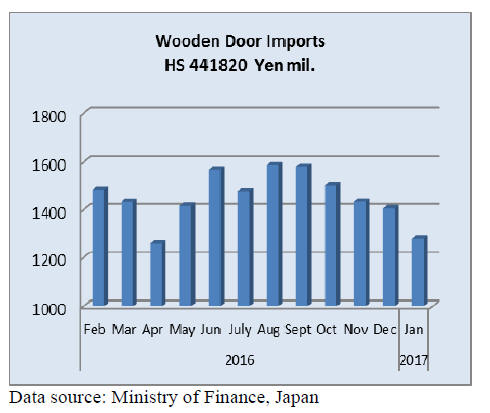
Windows
There was a sharp drop in Japan’s year on year wooden
window imports in January 2017 (-19%) and compared to
a month earlier January 2017 imports dropped almost
25%. The January 2017 value of wooden window imports
was one of the lowest over the previous 12 months and
only just above the record low in September 2016.
As was the case in previous months shippers in China and
the Philippines dominated Japan’s imports of wooden
windows. Shipments of wooden windows in January 2017
from these top two suppliers accounted for over 80% of
imports.

Assembled flooring
Three categories of assembled flooring are included in the
data presented below, HS 441871, 72 and 79.
The continued increase in the value of imports of
assembled flooring is in sharp contrast to the trend in
imports of wooden doors and windows such that this is not
just a reflection of exchange rate fluctuations. The surge in
the construction of apartments in Japan is thought to
behind the unusual increase in imports of assembled
flooring.
From a year earlier, January 2017 imports of
assembled
flooring were up a staggering 63% and there was a rise of
17% in imports over levels in December 2016.
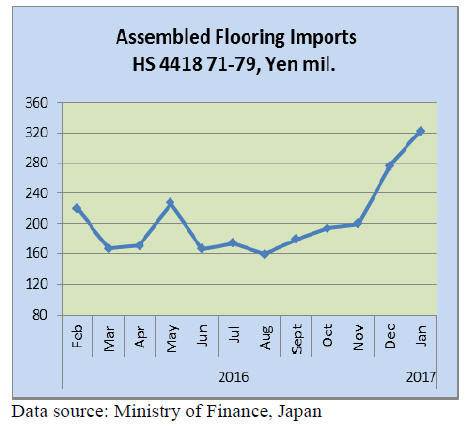
Plywood
The figure below shows the trend in imports of 4
categories of plywood, HS 441210/31/32 and 39.
Throughout 2016, as was the case in 2015, almost 90% of
Japan’s plywood imports are from Malaysia, Indonesia
and China. This trend continued into January 2017.
January 2017 arrivals of plywood from the top three
suppliers, Malaysia, Indonesia and China beat
expectations by rising 18%. January arrivals from
Malaysia surged 18% year on year, shipments from
Indonesia were up 6% but arrivals from China remained at
the same level as a year earlier.
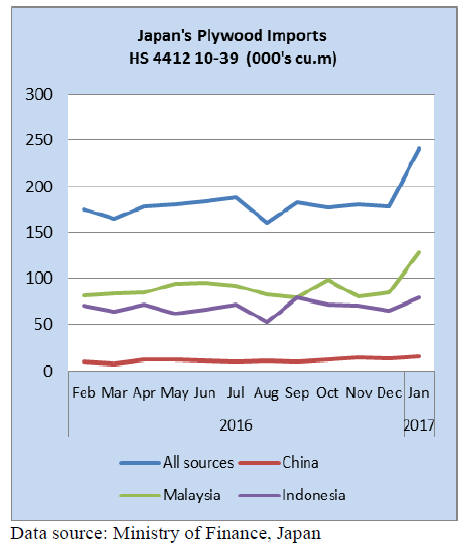 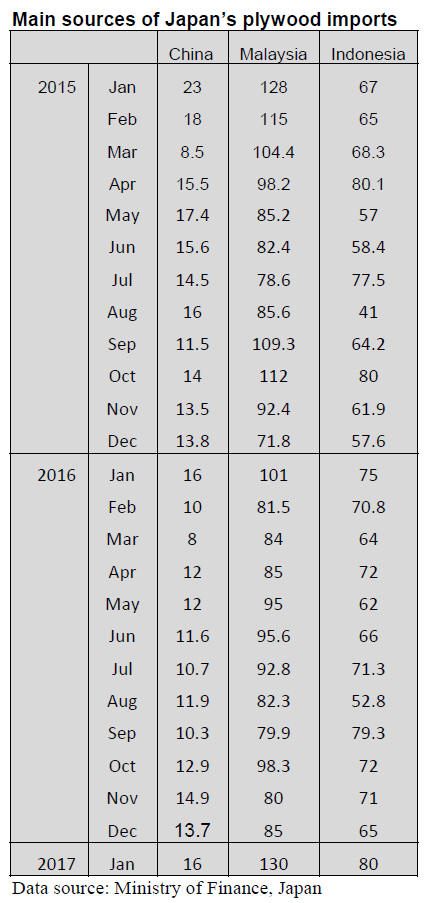
Trade news from the Japan Lumber Reports (JLR)
For the JLR report please see:
http://www.nmokuzai.
com/modules/general/index.php?id=7
Clean Wood Act
The Act on promotion, use and distribution of legally
harvested wood and wood products will be effective May
20, 2017.
Basic draft of ministry ordinance of effective regulation
and standard of judgment is disclosed on February 22 and
public opinion is invited until March 23.
Since wooden building needs variety of materials, the act
is made with flexibility to register legally proven materials
only.
The act requires and promotes use of legally proven
wood
materials for users of wooden products such as
manufacturers, distributors, house buildering companies
and contractors.
This is promotion method, not regulation like the Building
Standards Act so it is up to individual’s decision. Anyone,
which wishes to follow the act, will register to the
organizations and tries to procure and market legally
proven wood products.
Method of legality proof has three methods. One is group
verification, which is selected by the Green Purchase law
then second is Forest Certification systems. Third is
independent method by individual company. Also local
wood certification by prefectures can be used as
verification method. Forest Certifications are considered
as verification method.
Details of group certification may have some changes in
languages of legal certification such as registration of
harvest. For imported wood products, it is necessary to
have confirmation if the products are conformed to law of
country of origin and legal certification systems.
The Forestry Agency will publicize information of
producing countries on its web pages.
Wood products, which are not proven even after effort to
seek legality, can be handled as long as they are separated
from legal products.
The Forestry Agency commented that it would ask
cooperation to exporting countries not to increase wood
products without legal certification through diplomatic
channels and it is important that exporting countries
should have system to prove legality.
There are many demands to start handling legally certified
products first so registration system would have system to
register partially. For instance, housing company registers
domestic wood.
North American and European products for structural
members then withholds certification of other materials
until system to certify legality is established.
For some wooden building materials manufacturers have
three different series of products, they can register only
one first and withhold rest of series. After all, this aims to
promote use of legally proven wood products without any
penalty.
Plywood
New orders by precutting plants to plywood manufacturers
are declining but demand to deliver orders, which are
delayed, is strong. Movement of import plywood
continues to be dull so the importers are watching the
market before book closing at the end of March.
The importers and wholesalers need to increase the sales
prices after cargoes, which cost is high with weak yen in
late last year, arrive from now on.
January production of softwood plywood in January was
227,700 cbm, 1.4% more than January last year and 4.6%
less than December. Fewer working days in December by
year-end holidays and lower efficiency of drying by cold
weather in the North East and Japan Sea side plants caused
lower production.
The shipment in December was 235,000 cbms, 1.1% less
and 1.8% less. The shipment exceeded production
by7,200cbms. Precutting plants were busy in January to
catch up delayed orders.
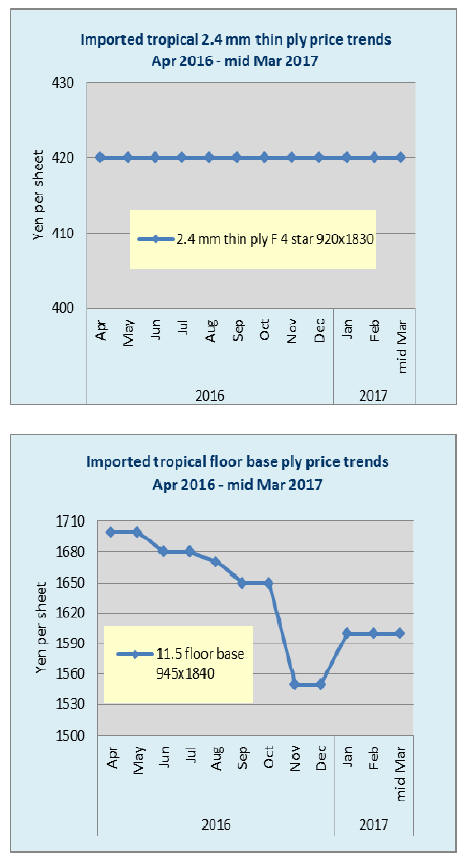 
Plywood plants continue full production because
mills in
Eastern Japan carry about a month of delivery delay and
Western Japan mills have maximum of three months of
delay. The inventory dropped down to 83,300 cbms, 7,200
cbms less than December so tightness continues.
January arrivals of imported plywood were 308,500 cbms,
17.4% more and 32.1% more. Malaysia supplied 133,400
cbms, 28.5% and 51.8% more.
Indonesia 88,500 cbms, 6.5% and 23.2% more.
China69,000 cbms. Delay the customs clearance in
December and more orders placed by the importers for
tight items are the reasons of higher volume. Cargoes
coming in after March are high cost by weak yen so the
importers need to push the prices.
|